陕西省某二中2013届高三英语二轮复习精品课件:名词
文档属性
| 名称 | 陕西省某二中2013届高三英语二轮复习精品课件:名词 | 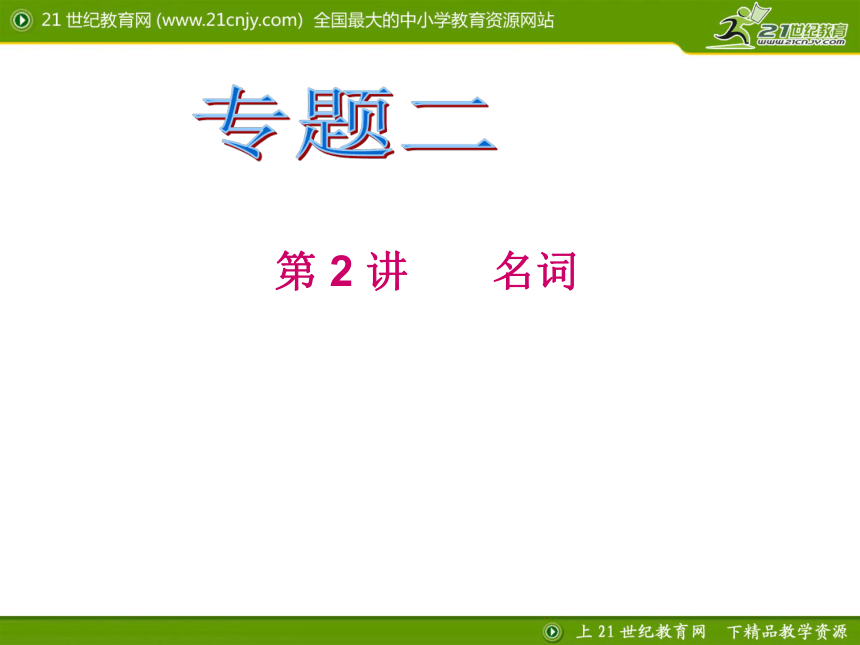 | |
| 格式 | zip | ||
| 文件大小 | 170.6KB | ||
| 资源类型 | 教案 | ||
| 版本资源 | |||
| 科目 | 英语 | ||
| 更新时间 | 2012-06-22 14:44:47 | ||
图片预览

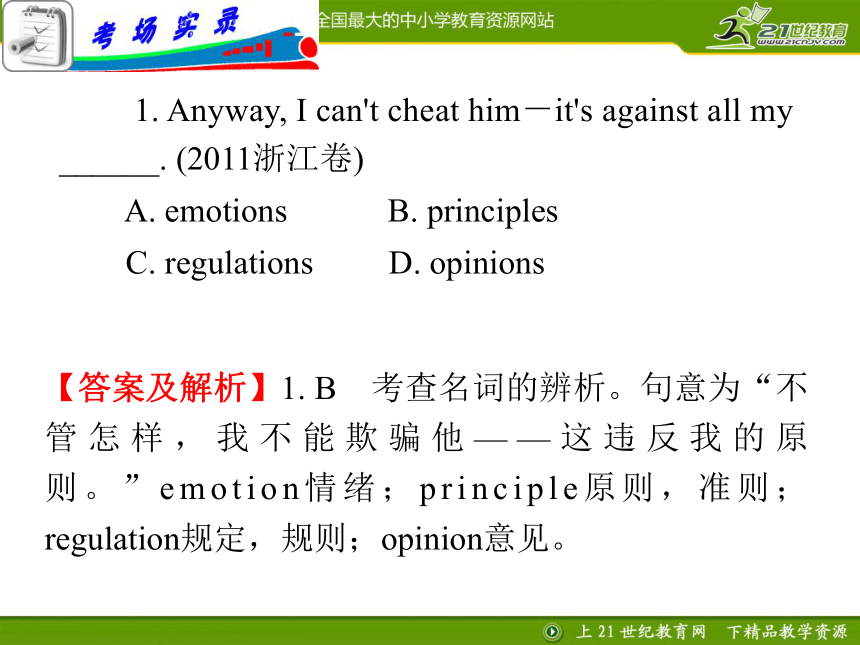
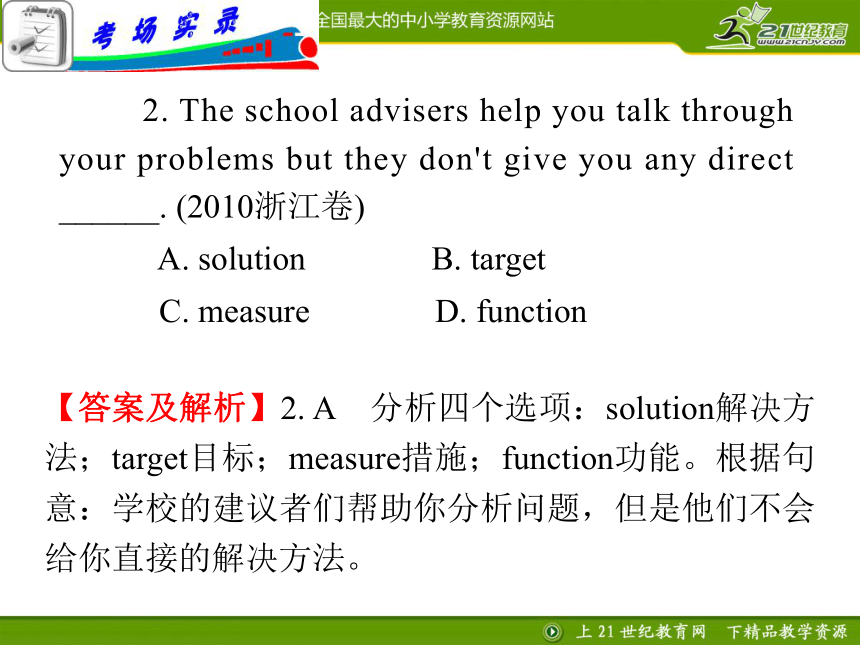

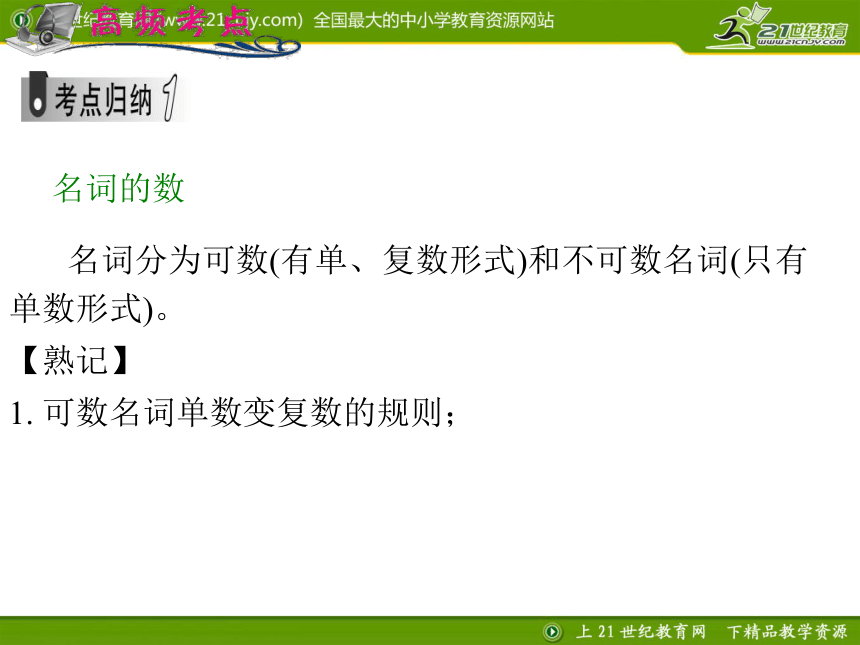

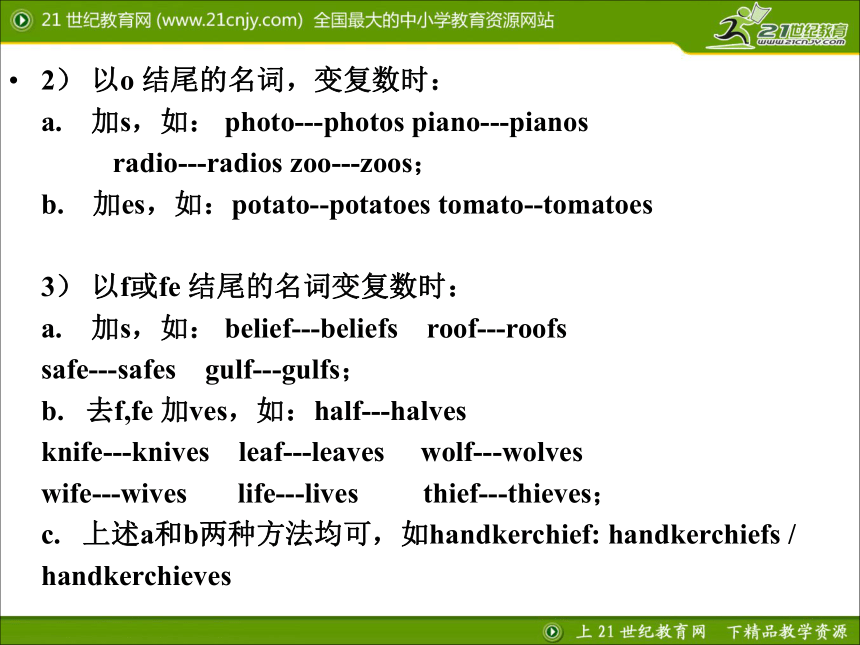
文档简介
(共17张PPT)
第 2 讲 名词
1. Anyway, I can't cheat him-it's against all my ______. (2011浙江卷)
A. emotions B. principles
C. regulations D. opinions
【答案及解析】1. B 考查名词的辨析。句意为“不管怎样,我不能欺骗他——这违反我的原则。”emotion情绪;principle原则,准则;regulation规定,规则;opinion意见。
2. The school advisers help you talk through your problems but they don't give you any direct ______. (2010浙江卷)
A. solution B. target
C. measure D. function
【答案及解析】2. A 分析四个选项:solution解决方法;target目标;measure措施;function功能。根据句意:学校的建议者们帮助你分析问题,但是他们不会给你直接的解决方法。
3. The system has been designed to give students quick and easy ______ to the digital resources of the library. (2009浙江卷)
A. access B. passage
C. way D. approach
【答案及解析】3. A 句意为“设计这个系统的目的是给同学们提供快速且容易使用图书馆电子资源的机会。”give sb. access to sth. 或have access to sth. 是固定词组,表示“有接近或使用某物的机会或权利”。
名词分为可数(有单、复数形式)和不可数名词(只有单数形式)。
【熟记】
1. 可数名词单数变复数的规则;
名词的数
1.1 名词复数的规则变化 一般情况 加 -s 清辅音后读/s/ map-maps 浊辅音和元音后读 /z/ bag-bags /car-cars 以s, sh, ch, x等结尾 加 -es 读 /iz/ bus-buses/ watch-watches 以ce, se, ze,等结尾 加 -s 读 /iz/ license-licenses 以辅音字母+y结尾 变y 为i再加es 读 /z/ baby---babies 1.2 其它名词复数的规则变化 1) 以y结尾的专有名词,或元音字母+y 结尾的名词变复数时,直接加s变复数。例如: two Marys-- the Henrys monkey---monkeys holiday---holidays
2) 以o 结尾的名词,变复数时: a. 加s,如: photo---photos piano---pianos radio---radios zoo---zoos; b. 加es,如:potato--potatoes tomato--tomatoes 3) 以f或fe 结尾的名词变复数时: a. 加s,如: belief---beliefs roof---roofs safe---safes gulf---gulfs; b. 去f,fe 加ves,如:half---halves knife---knives leaf---leaves wolf---wolves wife---wives life---lives thief---thieves; c. 上述a和b两种方法均可,如handkerchief: handkerchiefs / handkerchieves
1.3 名词复数的不规则变化
1) child---children foot---feet tooth---teeth mouse---mice man---men woman---women 注意:由一个词加 man 或 woman构成的合成词,其复数形式也是 -men 和-women,如an Englishman,two Englishmen。但German不是合成词,故复数形式为Germans;Bowman是姓,其复数是the Bowmans。 2)集体名词,以单数形式出现,但实为复数。
例如: people, police, cattle 等本身就是复数,不能说 a people,a police,a cattle,但可以说a person,a policeman,a head of cattle, the English,the British,the French,the Chinese,the Japanese,the Swiss 等名词,表示国民总称时,作复数用,如The Chinese are industries and brave. 中国人民是勤劳勇敢的。
3) 以s结尾,仍为单数的名词,如: a. maths,politics,physics等学科名词,一般是不可数名词,为单数。 b. news 为不可数名词。 c. the United States,the United Nations 应视为单数。 The United Nations was organized in 1945. 联合国是1945年组建起来的。 d. 以复数形式出现的书名,剧名,报纸,杂志名,也可视为单数。例如: "The Arabian Nights" is a very interesting story-book. 《一千零一夜》是一本非常有趣的故事书。 4) 表示由两部分构成的东西,如:glasses (眼镜)trousers, clothes等,若表达具体数目,要借助数量词 pair(对,双); suit(套); a pair of glasses; two pairs of trousers等。 5) 另外还有一些名词,其复数形式有时可表示特别意思,如:goods货物,waters水域,fishes(各种)鱼。
注意:
不规则变化:
man →men, woman →women, goose →geese, foot →feet, tooth →teeth, child →children, mouse →mice, ox →oxen
German →Germans。
复合名词的复数形式:
editor in chief→editors in chief,
daughter in law→daughters in law,
grown up→grown ups,
woman teacher→women teachers,
man driver →men drivers
名词的数
名词的所有格在句中表示所有关系,作定语用。
1.有生命名词的所有格一般在词尾加上“‘”或“’s”。如:Tom’s bike, Engles’s (Engles’) works, Women’s Day, the editor in chief’s office。
2. 如果一个事物为两个人共有,只在后一个名词的词尾加“'s”,如果不是共有,就要在两个名词的词尾都加上“'s”。如:Tom and Mike's room (共有),Tom's and Mike's rooms (不共有)。
名词的所有格
3. 表示时间、距离、国家、城市的无生命名词,可以在词尾加“'s”或“'”表示所有格,如:today's papers, ten minutes' walk。
4. 表示店铺或某人的家时,常在名词所有格之后省去shop, house, home。如:the tailor's, the chemist’s,
the doctor’s, the aunt’s
5. 无生命名词的所有格通常用of短语来表示。如:the window of the room, the cover of the book
名词的所有格
6. 表示有生命的名词有时也可用of短语来表示所有关系,尤其当该名词带有较长的定语时。如:the teachers of the No. 1 Middle School。
7. 双重所有格结构前的被修饰名词通常指整体中的部分或一个,双重所有格只能用于有生命的名词,这个名词是确定的。被修饰名词前有不定冠词、指示代词、疑问代词、不定代词或数词等限定词时,一般只能用双重所有格。如:an old friend of my uncle's, a daughter of Mrs. Green's, the house of one of my friends’。
名词的所有格
表材料、地点、用途、性质,泛指时间、整体等普通名词可以作定语,一般用单数形式。
stone figures(石像),paper money(纸币),country music(乡村音乐),river bank(河岸),school gate(校门口),traffic lights(交通灯),summer holidays(暑假),evening dress(晚礼服)。
但在个别情况下,也有需用复数的。
sports meet(运动会),the United States government(美国政府),students reading room(学生阅览室),goods train(货车),two men doctors(两个男医生)。
名词的普通格作定语
注意以下几组名词单复数问题:
1. 物质名词一般不用复数形式,但有些物质名词要用复数形式来表示不同的类别,如:
fishes(各种鱼),fruits(各种水果),steels(各种钢材)。
2. 物质名词表示数量时,一般用表示数量的短语来表示。如:
a cup of tea, three bags of apples, four pieces of bread。
易错易混点
3. 有些抽象名词的复数形式表示不同的含义。如:
work(工作)→ works(著作)
arm(手臂)→arms(军火)
glass(玻璃)→glasses(眼镜)
cloth(布)→clothes(衣服)
4. 定冠词加上姓氏的复数形式,表示全家人或夫妇二人;姓氏的复数形式前不加冠词,则表示若干个姓××的人。如:the Smiths史密斯夫妇或史密斯一家, three Wangs 3个姓王的。
易错易混点
5. 只用作单数的复数形式的名词。如:physics, mathematics, news, the United States。
6. 有些名词形似单数,但实为复数。如:police, people, cattle。
7. 有些名词如被看作整体时就作单数用,如被看作组成该集体的各个成员时就作复数用。如:class, family, couple, audience, government, public。
易错易混点
第 2 讲 名词
1. Anyway, I can't cheat him-it's against all my ______. (2011浙江卷)
A. emotions B. principles
C. regulations D. opinions
【答案及解析】1. B 考查名词的辨析。句意为“不管怎样,我不能欺骗他——这违反我的原则。”emotion情绪;principle原则,准则;regulation规定,规则;opinion意见。
2. The school advisers help you talk through your problems but they don't give you any direct ______. (2010浙江卷)
A. solution B. target
C. measure D. function
【答案及解析】2. A 分析四个选项:solution解决方法;target目标;measure措施;function功能。根据句意:学校的建议者们帮助你分析问题,但是他们不会给你直接的解决方法。
3. The system has been designed to give students quick and easy ______ to the digital resources of the library. (2009浙江卷)
A. access B. passage
C. way D. approach
【答案及解析】3. A 句意为“设计这个系统的目的是给同学们提供快速且容易使用图书馆电子资源的机会。”give sb. access to sth. 或have access to sth. 是固定词组,表示“有接近或使用某物的机会或权利”。
名词分为可数(有单、复数形式)和不可数名词(只有单数形式)。
【熟记】
1. 可数名词单数变复数的规则;
名词的数
1.1 名词复数的规则变化 一般情况 加 -s 清辅音后读/s/ map-maps 浊辅音和元音后读 /z/ bag-bags /car-cars 以s, sh, ch, x等结尾 加 -es 读 /iz/ bus-buses/ watch-watches 以ce, se, ze,等结尾 加 -s 读 /iz/ license-licenses 以辅音字母+y结尾 变y 为i再加es 读 /z/ baby---babies 1.2 其它名词复数的规则变化 1) 以y结尾的专有名词,或元音字母+y 结尾的名词变复数时,直接加s变复数。例如: two Marys-- the Henrys monkey---monkeys holiday---holidays
2) 以o 结尾的名词,变复数时: a. 加s,如: photo---photos piano---pianos radio---radios zoo---zoos; b. 加es,如:potato--potatoes tomato--tomatoes 3) 以f或fe 结尾的名词变复数时: a. 加s,如: belief---beliefs roof---roofs safe---safes gulf---gulfs; b. 去f,fe 加ves,如:half---halves knife---knives leaf---leaves wolf---wolves wife---wives life---lives thief---thieves; c. 上述a和b两种方法均可,如handkerchief: handkerchiefs / handkerchieves
1.3 名词复数的不规则变化
1) child---children foot---feet tooth---teeth mouse---mice man---men woman---women 注意:由一个词加 man 或 woman构成的合成词,其复数形式也是 -men 和-women,如an Englishman,two Englishmen。但German不是合成词,故复数形式为Germans;Bowman是姓,其复数是the Bowmans。 2)集体名词,以单数形式出现,但实为复数。
例如: people, police, cattle 等本身就是复数,不能说 a people,a police,a cattle,但可以说a person,a policeman,a head of cattle, the English,the British,the French,the Chinese,the Japanese,the Swiss 等名词,表示国民总称时,作复数用,如The Chinese are industries and brave. 中国人民是勤劳勇敢的。
3) 以s结尾,仍为单数的名词,如: a. maths,politics,physics等学科名词,一般是不可数名词,为单数。 b. news 为不可数名词。 c. the United States,the United Nations 应视为单数。 The United Nations was organized in 1945. 联合国是1945年组建起来的。 d. 以复数形式出现的书名,剧名,报纸,杂志名,也可视为单数。例如: "The Arabian Nights" is a very interesting story-book. 《一千零一夜》是一本非常有趣的故事书。 4) 表示由两部分构成的东西,如:glasses (眼镜)trousers, clothes等,若表达具体数目,要借助数量词 pair(对,双); suit(套); a pair of glasses; two pairs of trousers等。 5) 另外还有一些名词,其复数形式有时可表示特别意思,如:goods货物,waters水域,fishes(各种)鱼。
注意:
不规则变化:
man →men, woman →women, goose →geese, foot →feet, tooth →teeth, child →children, mouse →mice, ox →oxen
German →Germans。
复合名词的复数形式:
editor in chief→editors in chief,
daughter in law→daughters in law,
grown up→grown ups,
woman teacher→women teachers,
man driver →men drivers
名词的数
名词的所有格在句中表示所有关系,作定语用。
1.有生命名词的所有格一般在词尾加上“‘”或“’s”。如:Tom’s bike, Engles’s (Engles’) works, Women’s Day, the editor in chief’s office。
2. 如果一个事物为两个人共有,只在后一个名词的词尾加“'s”,如果不是共有,就要在两个名词的词尾都加上“'s”。如:Tom and Mike's room (共有),Tom's and Mike's rooms (不共有)。
名词的所有格
3. 表示时间、距离、国家、城市的无生命名词,可以在词尾加“'s”或“'”表示所有格,如:today's papers, ten minutes' walk。
4. 表示店铺或某人的家时,常在名词所有格之后省去shop, house, home。如:the tailor's, the chemist’s,
the doctor’s, the aunt’s
5. 无生命名词的所有格通常用of短语来表示。如:the window of the room, the cover of the book
名词的所有格
6. 表示有生命的名词有时也可用of短语来表示所有关系,尤其当该名词带有较长的定语时。如:the teachers of the No. 1 Middle School。
7. 双重所有格结构前的被修饰名词通常指整体中的部分或一个,双重所有格只能用于有生命的名词,这个名词是确定的。被修饰名词前有不定冠词、指示代词、疑问代词、不定代词或数词等限定词时,一般只能用双重所有格。如:an old friend of my uncle's, a daughter of Mrs. Green's, the house of one of my friends’。
名词的所有格
表材料、地点、用途、性质,泛指时间、整体等普通名词可以作定语,一般用单数形式。
stone figures(石像),paper money(纸币),country music(乡村音乐),river bank(河岸),school gate(校门口),traffic lights(交通灯),summer holidays(暑假),evening dress(晚礼服)。
但在个别情况下,也有需用复数的。
sports meet(运动会),the United States government(美国政府),students reading room(学生阅览室),goods train(货车),two men doctors(两个男医生)。
名词的普通格作定语
注意以下几组名词单复数问题:
1. 物质名词一般不用复数形式,但有些物质名词要用复数形式来表示不同的类别,如:
fishes(各种鱼),fruits(各种水果),steels(各种钢材)。
2. 物质名词表示数量时,一般用表示数量的短语来表示。如:
a cup of tea, three bags of apples, four pieces of bread。
易错易混点
3. 有些抽象名词的复数形式表示不同的含义。如:
work(工作)→ works(著作)
arm(手臂)→arms(军火)
glass(玻璃)→glasses(眼镜)
cloth(布)→clothes(衣服)
4. 定冠词加上姓氏的复数形式,表示全家人或夫妇二人;姓氏的复数形式前不加冠词,则表示若干个姓××的人。如:the Smiths史密斯夫妇或史密斯一家, three Wangs 3个姓王的。
易错易混点
5. 只用作单数的复数形式的名词。如:physics, mathematics, news, the United States。
6. 有些名词形似单数,但实为复数。如:police, people, cattle。
7. 有些名词如被看作整体时就作单数用,如被看作组成该集体的各个成员时就作复数用。如:class, family, couple, audience, government, public。
易错易混点
